Lesson 3.6: Attention
Key Issues with Recurrent Models (RNNs/LSTMs)
-
Linear Interaction Distance
-
For distant word pairs (e.g., "The cat [...] sat"), RNNs require O(sequence length) steps to interact.
-
Problem:
- Vanishing/exploding gradients make it hard to learn long-range dependencies.
- Linear word order is artificially enforced, while language is hierarchical (e.g., syntax trees).
-
Sequential Computation
- RNNs process tokens one at a time, creating a bottleneck:
- Forward/backward passes require O(sequence length) unparallelizable steps.
- GPUs thrive on parallel computation, but RNNs force sequential dependency.
- RNNs process tokens one at a time, creating a bottleneck:
-
Information Bottleneck
- The final hidden state of an encoder RNN must compress all source information into a fixed-size vector.
- Result: Loss of fine-grained details, especially for long sequences.
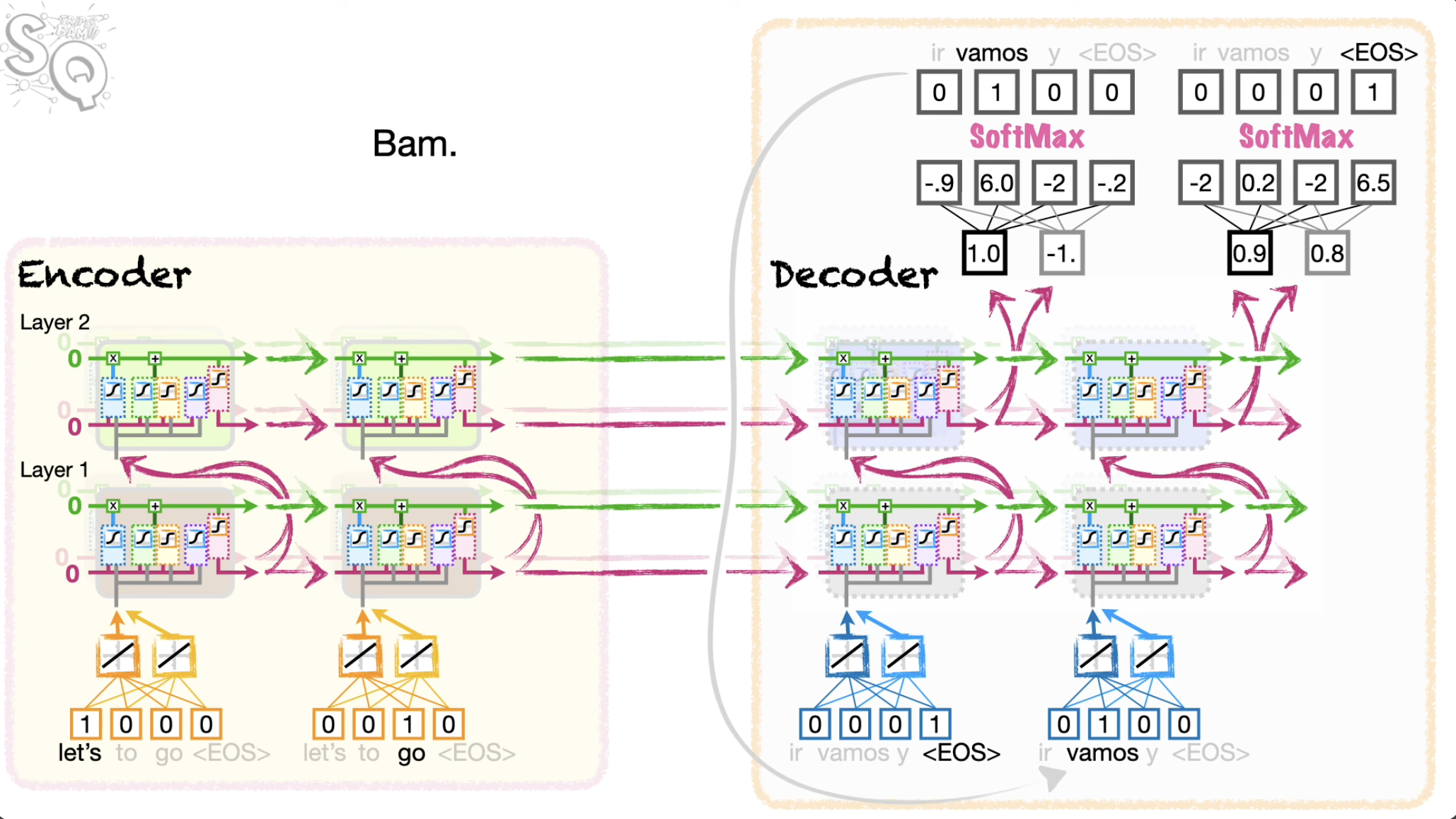
Sequence-to-Sequence (Seq2Seq) with Attention
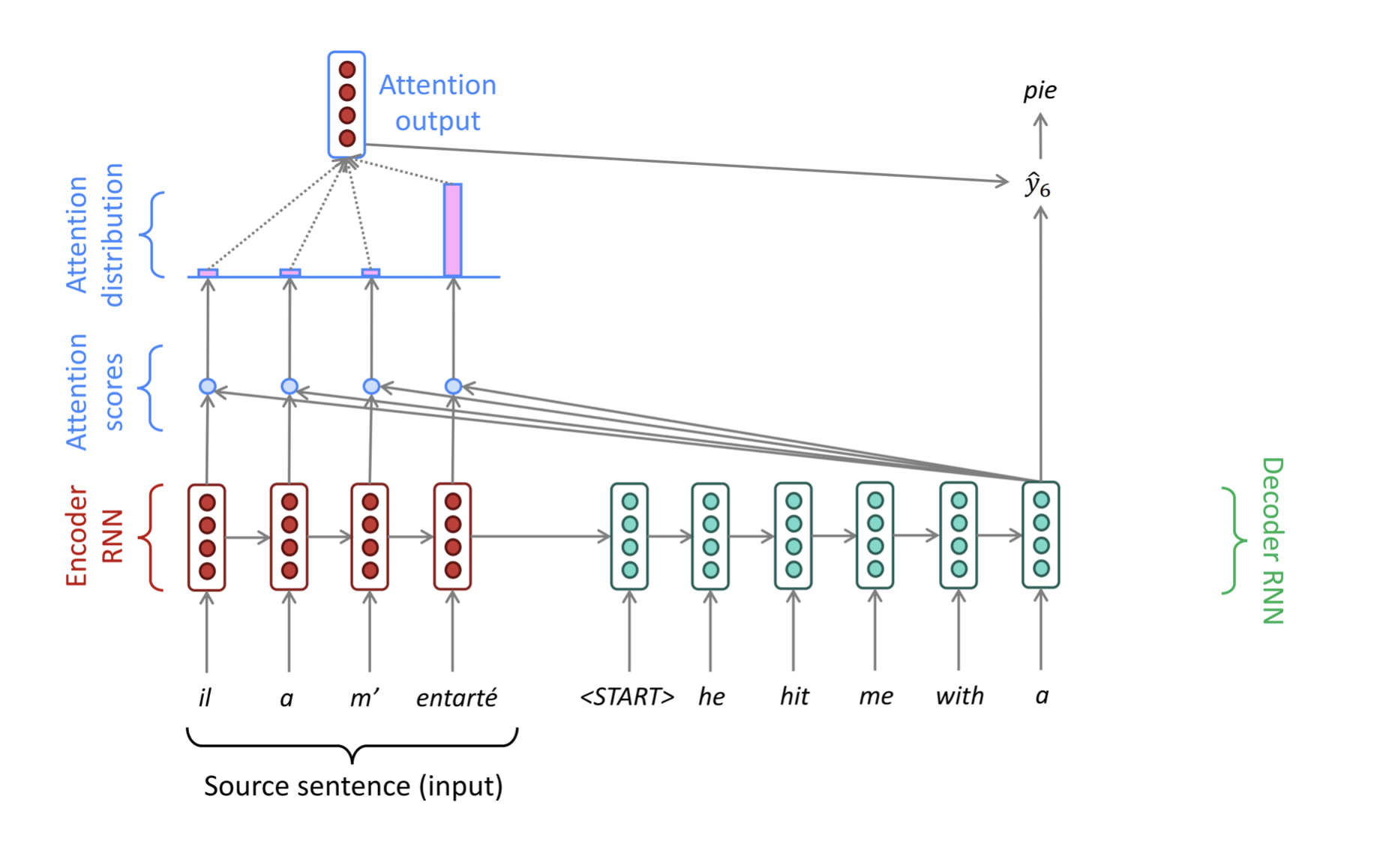
Core idea: on each step of the decoder, use direct connection to the encoder to focus on a particular part of the source sequence
-
Input Processing (Encoder)
- The input sequence (e.g., a sentence like "How are you?") is fed into the encoder (usually a BiLSTM or Transformer).
- Each word is converted into a vector (embedding), and the encoder processes them sequentially.
- Key steps:
- Embedding
- Words → Vectors:
- "How" → [0.2, -0.5, ...], "are" → [0.7, 0.1, ...], ...
- Hidden States:
- The encoder generates a hidden state for each word, capturing its context:
- h₁ ("How"), h₂ ("are"), h₃ ("you"), h₄ ("?")
- Output: A sequence of encoder states
- Embedding
-
Decoder Initialization
- The decoder (usually an LSTM) starts with:
- Initial hidden state: Set to the encoder’s last state
- First input: A special
<SOS>(Start-of-Sequence) token or also<EOS>. - Purpose: Prepares the decoder to generate the first word of the output (e.g., a translation).
-
Decoder Step with Attention (Iterative Process)
- For each output word (e.g., generating Spanish "¿Cómo estás?"):
- Step 3.1: Compute Attention Weights
- The decoder calculates how much to "focus" on each encoder state for the current step.
- Uses the decoder’s previous hidden state and all the encoder states .
- Scores: For each encoder state :
- Weights: Softmax turns scores into probabilities
- Example: For the decoder step generating "Cómo", (for "How") might be 0.9.
- Step 3.2: Create Context Vector
- The encoder states are weighted by and summed:
- Example: If generating "Cómo", (since "How" → "Cómo").
- Step 3.3: Update Decoder State
- Previous hidden state
- Context vector
- Previously predicted word (or
<SOS>for the first step).
- Step 3.4: Predict Next Word
- The decoder predicts a probability distribution over the output vocabulary:
- Repeat: Steps 3.1 - 3.4 until
<EOS>(End-of-Sequence) is generated.
Attention is Great
- Attention significantly improves NMT performance
- It’s very useful to allow decoder to focus on certain parts of the source
- Attention provides a more “human-like” model of the MT process
- You can look back at the source sentence while translating, rather than needing to remember it all
- Attention solves the bottleneck problem
- Attention allows decoder to look directly at source; bypass bottleneck
- Attention helps with the vanishing gradient problem
- Provides shortcut to faraway states
- Attention provides some interpretability
- By inspecting attention distribution, we see what the decoder was focusing on
- We get (soft) alignment for free!
- This is cool because we never explicitly trained an alignment system
- The network just learned alignment by itself
Attention in equations
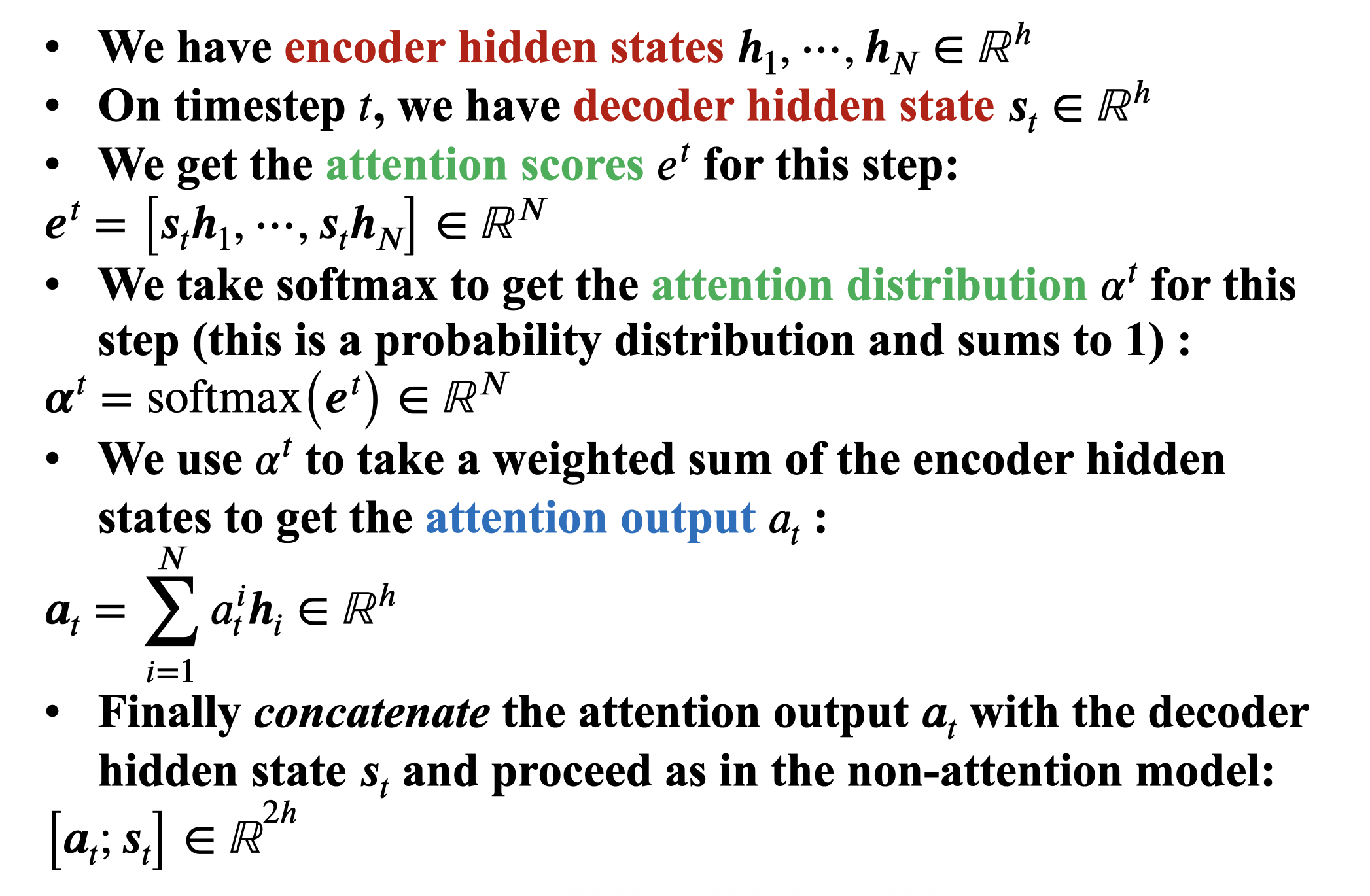
Why Attention Solves Parallelization & Bottleneck Problems
- Parallel Computation of Attention Scores
- All attention scores can be computed simultaneously for the entire sequence:
- (Where = query for position , = key for position )
- Eliminating Sequential Bottlenecks
- Unlike RNNs which require O(N) sequential operations, attention computes all positions at once:
-
- are matrices containing all queries/keys/values
- Single matrix multiplication replaces sequential processing
- Constant Interaction Distance
- Any two words can interact directly in one layer:
- Self-Attention Within a Sentence
- The same mechanism works for encoder self-attention:
-
- Each position attends to all positions in parallel
- No information bottleneck - all positions remain accessible
Why This Matters
- Training Speed: Attention layers utilize GPU parallelism fully
- Model Quality: Direct access to all positions helps learn complex dependencies
- Scalability: Constant path length regardless of sequence length
Basic Attention Framework
For query q, values V = , and keys K = :
- Attention Scores:
- Attention Distribution (softmax):
- Context Vector (weighted sum):
Common Attention Variants
- Dot-Product Attention
- Pros: Computationally efficient.
- Cons: Scores can grow large in magnitude ( unstable gradients).
- Scaled Dot-Product (Transformer Attention)
- Why scale?: Prevents gradient saturation when (key dimension) is large.
- Additive Attention
- Pros: More expressive.
- Cons: Slower (extra parameters ).
- Multi-Head Attention
- Key idea: Parallel attention heads capture different relationships.
- Self-Attention (Special Case)
- When queries, keys, and values come from the same sequence ( are all linear transforms of input ):
More general definition of attention:
- Given a set of vector values, and a vector query, attention is a technique to compute a weighted sum of the values, dependent on the query.
- Intuition:
- The weighted sum is a selective summary of the information contained in the values, where the query determines which values to focus on.
- Attention is a way to obtain a fixed-size representation of an arbitrary set of representations (the values), dependent on some other representation (the query).
- Upshot:
- Attention has become the powerful, flexible, general way pointer and memory manipulation in all deep learning models.
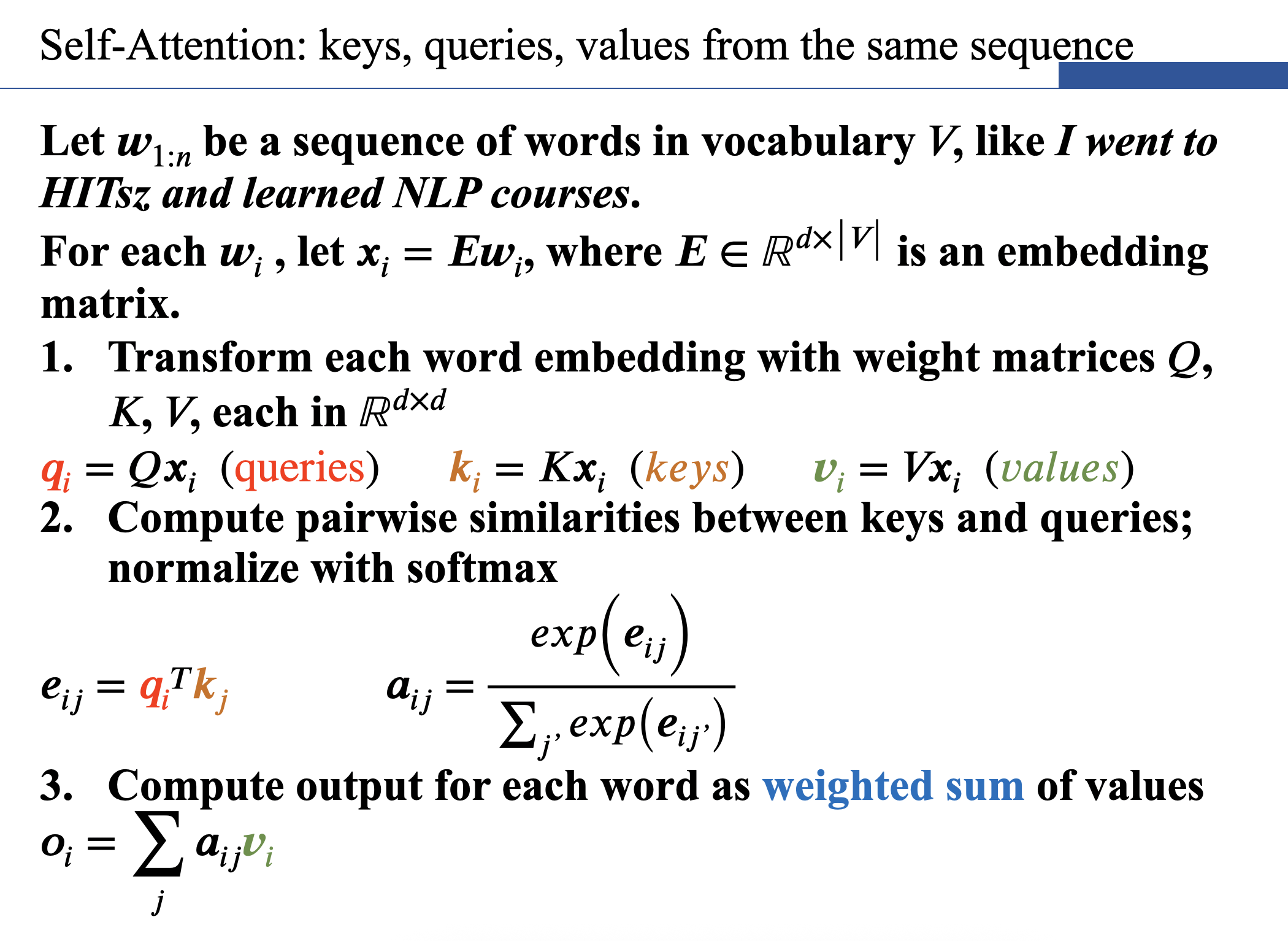
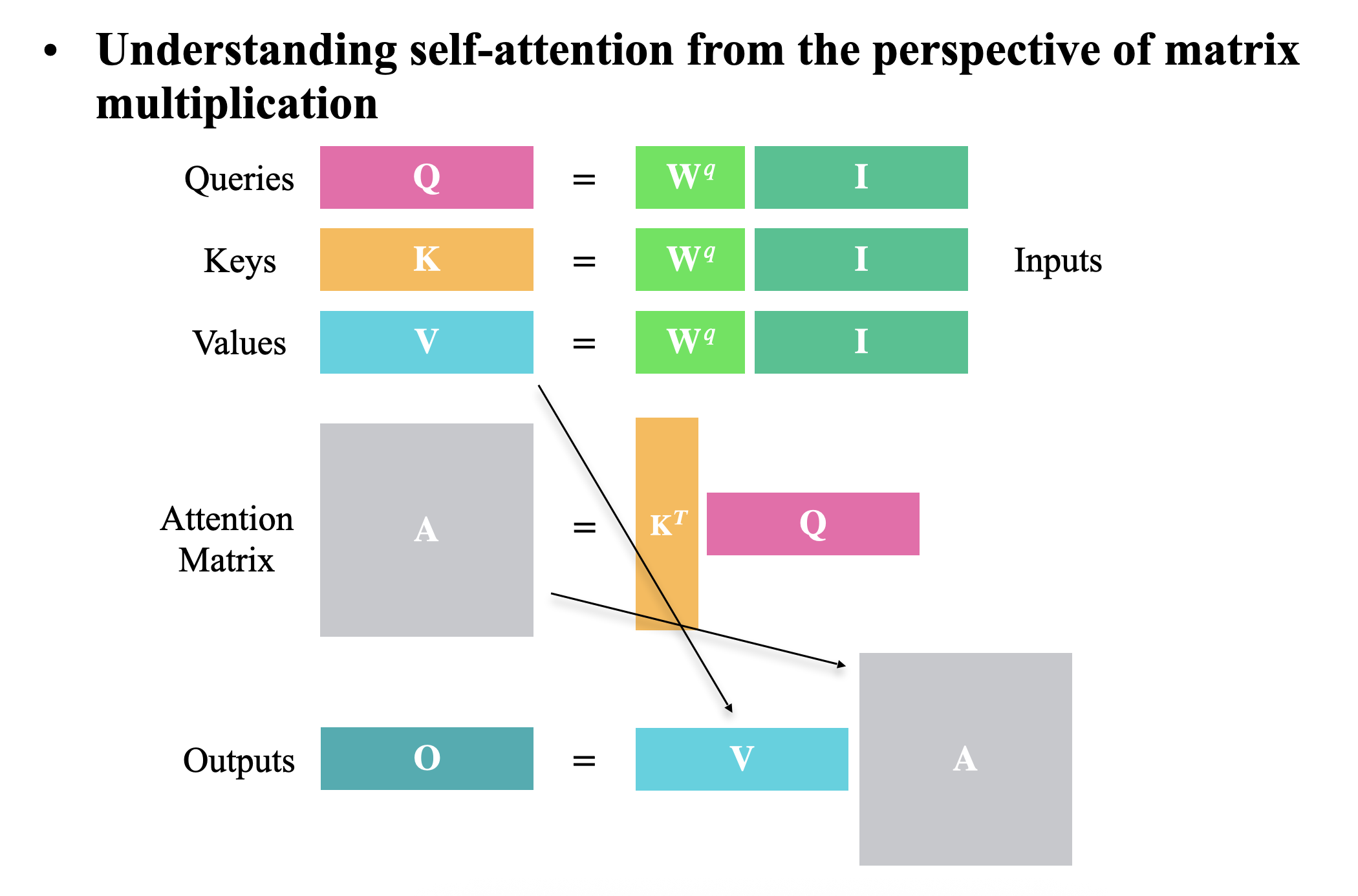
Barriers and Solutions for Self-Attention as a Building Block
Barrier 1: Lack of Inherent Order
- Problem:
- Self-attention treats inputs as a bag of words—it has no built-in notion of position.
- For example: "Dog bites man" vs. "Man bites dog" would have identical representations without positional cues.
- Solution: Positional Encodings Inject position information into the input embeddings. Two main approaches:
- Sinusoidal Positional Encodings
- Idea: Use fixed, periodic sinusoidal functions to encode positions.
- Equation:
- For position and dimension
- (Where = embedding dimension)
- Intuition:
- Periodicity: Different frequencies capture varying scales of positional relationships.
- Extrapolation: Theoretically generalizes to longer sequences (though rarely works in practice).
- Pros:
- No learned parameters (fixed).
- Periodicity may help generalization.
- Cons:
- Not adaptive to data.
- Fails to extrapolate reliably.
- Learned Positional Embeddings
- Idea: Treat positions as learnable vectors (like word embeddings).
- Equation:
- Each is trained via backpropagation.
- Pros:
- Adapts to data (e.g., learns syntax-aware positions).
- Simpler implementation.
- Cons:
- Cannot extrapolate beyond trained sequence length .
- Requires more memory.
- Used By: Most modern Transformers (e.g., BERT, GPT).
How Positional Encodings Are Integrated
- Step: Add (or concatenate) positional embeddings to input word embeddings:
- Why Addition?
- Empirically works better than concatenation (fewer parameters, similar performance).
- The Transformer’s self-attention can "disentangle" position and content implicitly.
Barrier 2: Lack of Nonlinearity in Self-Attention
- Problem: Self-attention is fundamentally a weighted average of value vectors. Without nonlinearities, stacking multiple self-attention layers is equivalent to a single averaged representation:
- No "deep learning magic": Pure linear transformations + softmax (which is monotonic) cannot learn complex hierarchical features.
- Why: Stacking linear self-attention layers reduces to a single linear operation:
- (No new representational power is gained!)
- Solution: Add Feedforward Networks (FFNs)
- Fix: Apply a position-wise FFN after each self-attention layer to introduce nonlinearity.
- Equation: For each output vector from self-attention:
- (Where )
- Key Properties:
- Nonlinearity: ReLU breaks linearity, enabling hierarchical feature learning.
- Position-Wise: Applied independently to each token (parallelizable).
- Why This Works
- Self-Attention: Mixes information across positions (weighted average).
- FFN: Processes each position independently with nonlinear transformations.
- Think of it as a "per-token MLP" that refines features.
- Analogy:
- Self-attention = "global communication" (tokens talk to each other).
- FFN = "local computation" (each token thinks independently).
Barrier 3: Preventing Future Peeking in Decoders
-
Problem: In tasks like language modeling or machine translation, the model must predict the next word without seeing future tokens.
-
Example: When predicting "estás" in "¿Cómo ___?", the model shouldn’t see "estás" or "?" in the input.
-
Challenge: Standard self-attention attends to all tokens in parallel → leaks future info.
-
Solution: Masked Self-Attention
- Artificially set attention weights to 0 for future positions.
-
Step-by-Step Implementation
- Compute Attention Scores (as usual):
- Apply Mask (for decoder at position i):
- Effect: Future tokens get exp(-∞) = 0 after softmax
- Compute Attention Output:
- Compute Attention Scores (as usual):
-
Why This Works
- Parallelization: All positions computed simultaneously (unlike RNNs), but future tokens are masked.
- Causality: Each token only attends to itself and prior tokens.
- Efficiency: Implemented via a lower-triangular mask (see code below).
The 4 Essential Components of a Self-Attention Building Block
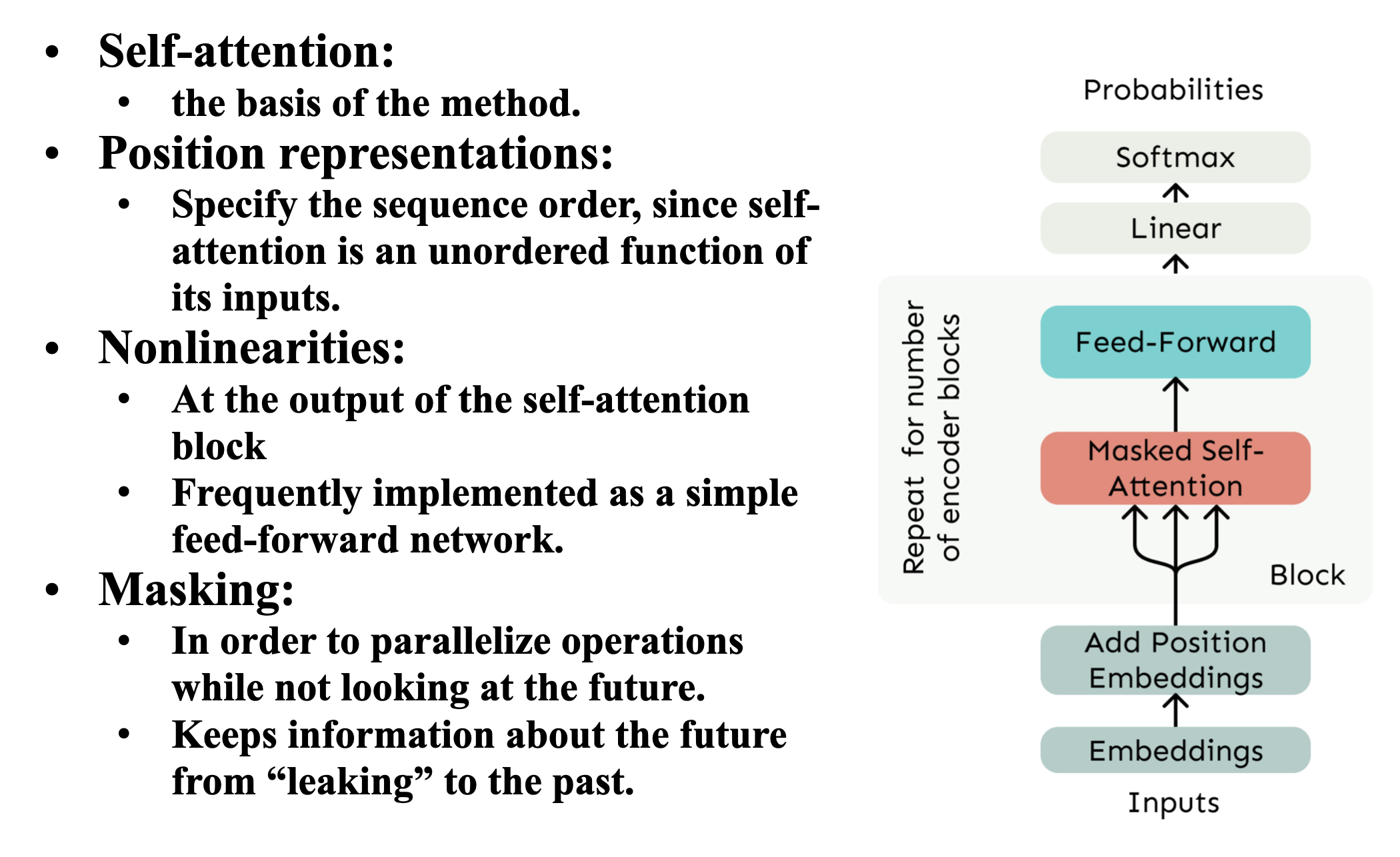
- Self-Attention (Core Mechanism)
- Allows each token to dynamically focus on relevant parts of the sequence.
- Computes relationships between all pairs of tokens.
-
- Queries (Q): What each token is looking for.
- Keys (K): What each token contains.
- Values (V): Actual content being retrieved.
- Without self-attention, the model has no way to learn contextual relationships between tokens.
- Position Representations
- Injects information about token order since self-attention is permutation-equivariant.
- Sinusoidal Encoding (Fixed):
- Learned Embeddings (Trainable):
- Implementation:
x = token_embeddings + position_embeddings # Additive (most common)
- Nonlinearities (Feed-Forward Network)
- Introduces nonlinear transformations to enable hierarchical feature learning.
- Why It's Needed: Pure self-attention is just weighted averaging - FFNs add representational power.
- Masking (for Autoregressive Tasks)
- Prevents the model from "cheating" by looking at future tokens during training.
- Why It's Needed: Ensures predictions at position i depend only on tokens 1 to i-1 (crucial for language modeling).
How These Components Work Together
- Input: Token embeddings + positional encodings.
- Self-Attention: Computes contextual relationships.
- Masking: Optional - applied in decoder for autoregressive tasks.
- FFN: Further processes each token's representation.